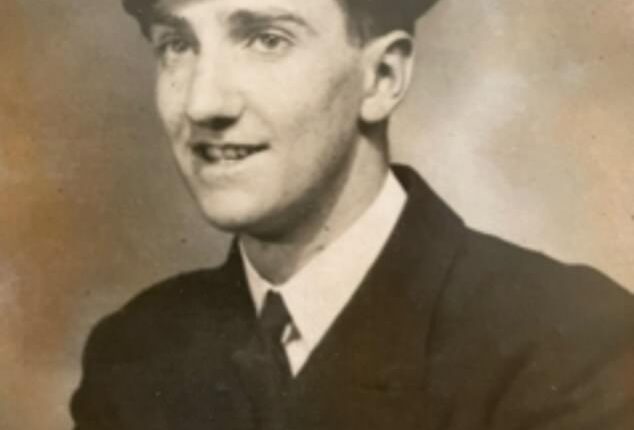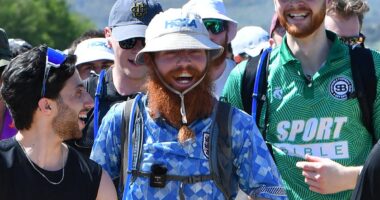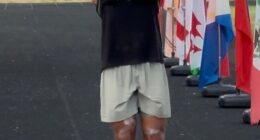Kavita Puri is an award-winning journalist, executive producer and broadcaster for the BBC. She is also the author of the critically acclaimed book ‘Partition Voices: Untold British Stories’.
Here, she speaks to survivors of Japanese Prisoner of War camps to mark VJ Day.
Peter Knight, 98, is telling me about the day he heard the news of the attacks against the US Naval base at Pearl Harbor.
While he was surprised at the Japanese raids, it’s what happened hours later that shocked him.
‘The Japanese have been and invaded part of the British Empire’ he tells me.
British colonies across South East Asia including Malaya (Malaysia) and Singapore, were attacked. ‘This can’t be happening.’ Peter thought.
He was a schoolboy in early December 1941 and had been following the war against the Nazis in Europe on a map in his living room in Bromley, a suburb of London.
Now there was a new front, and a new enemy. This was a war between two mighty imperial powers – Britain and Japan – for territory and valuable resources.
Peter put up a second map to follow the progress of the war in Asia and the Pacific.
Within months, places that had been part of Britain’s empire for over a century had fallen to Japan, like Malaya, Singapore, and Burma (now Myanmar).

Peter Knight fought against Japanese forces in the navy during WWII after British colonies were falling

Now 98, he said that he felt at the time ‘that’s not our war. The here and now was us being bombed. That was our war. It was such a long way away’

The Royal Family wave to jubilant crowds from the Buckingham Palace balcony on VJ Day, August 15, 1945. Left to right: Princess Elizabeth, Queen Elizabeth, King George VI and Princess Margaret
Peter felt disbelief. Loss of these key British territories was humiliating. Though he didn’t say it out loud, at the time Peter felt ‘that’s not our war. The here and now was us being bombed. That was our war. It was such a long way away.’
He wonders today if that attitude ever went away.
Yet the faraway war would end up touching his life. By 1945, Peter was in the Navy and on his way to fight Japanese forces.
Peter’s second map was the inspiration for my new Radio 4 series to the mark the 80th anniversary of VJ – Victory over Japan – Day, which finally brought an end to World War Two.
As I discovered, there are so many homes in Britain that were touched by the war on the Asian front.
These experiences were different to the war in Europe – the battles were fought in malaria-infested jungles.
Prisoners – soldiers and civilians – were held in appalling conditions, some forced into labour.
But the war on the Asian front which affected tens of thousands of British lives, and many more of its then colonial subjects, is not as well-known as our fight against the Nazis.

Jubilant crowds gather outside Buckingham Palace, hoping to see the King, following news of Japan’s surrender, August 10, 1945

The Victoria Monument outside Buckingham Palace became a grandstand for jubilant spectators waiting to catch a glimpse of the Royal family on VJ Day, August 15, 1945

A policeman is held aloft by American military men in London on VJ Day, August 15, 1945

Londoners celebrate VJ Day in Trafalgar Square, August 15, 1945. Some naughty men and women climbed onto the fountain

Award-winning journalist Kavita Puri looked back on some of the stories that had been forgotten of soldiers who fought on the Asian front
VJ Day, which comes three months after VE – Victory in Europe – Day, can often feel like an afterthought.
80 years after the end of the war, I was lucky enough to interview some of the last surviving veterans, as well as descendants of those who lived through it.
Captain Yavar Abbas is 104 years old, but seems decades younger. He joined the 11th Sikh regiment after the fall of Burma in mid 1942, and soon applied to be a combat cameraman.
He became part of the new 14th Army, which had been put together, to learn the lessons from defeat and win back lost territory.
It would end up as a force of nearly a million men, the vast majority Indian and from other parts of the British empire. Though even at the time it was known as the ‘forgotten army.’
Yavar was filming at the siege of Imphal and Battle of Kohima in 1944 in north eastern India – pivotal battles which saw intense hand-to-hand fighting.
Japanese forces were successfully repelled, and the looming invasion of British India was thwarted.
Yavar squints as he remembers the sight of the enemy in the aftermath.

Captain Yavar Abbas joined the 11th Sikh regiment after the fall of Burma in mid 1942 before moving to the 14th Army, which went on to be known as the ‘forgotten army’ despite containing more than a million men

Now 104, he revisited his diary he wrote at the time, uncovering haunting memories of the razed city of Hiroshima that still gives him nightmares today
‘The Japanese offered no prisoners, only dead bodies scattered over the battlefield. Some of them with the swords they used to commit Harakiri, projecting from their rotting bodies.’
He says many Japanese soldiers would rather kill themselves than be captured.
Yavar kept a diary from the front line, which he wrote with his fountain pen.
When I meet him at his home in London, he reads me a part from his entry on 28 February 1945, when he was around 30 miles from Mandalay in Burma.
I think he is saying it out loud for the first time. ‘We are moving out in the first light of day. There’s every chance of my not coming back at all, but I’ve decided to take the risk…three times I’ve just been a couple of feet from death.’
But it’s what he saw in the aftermath of Hiroshima – where he was part of the Allied Occupying Force – that still haunts him today, and gives him nightmares.
He saw a city razed, and people with horrific injuries. Even at the time he felt ‘It was a crime against humanity to have dropped the bombs.’
29-year-old Shelagh Brown had no idea war was over on VJ Day on 15 August 1945.

‘We are moving out in the first light of day. There’s every chance of my not coming back at all, but I’ve decided to take the risk…three times I’ve just been a couple of feet from death,’ Captain Abbas reads to Kavita Puri
It was a day like all the others from the past three and a half years she had spent in captivity. Malnourished, weak, and recovering from numerous bouts of malaria, she was just trying to stay alive.
It was 6 weeks after the end of the war that a Japanese officer told all the prisoners in the civilian internment camp to gather under a tree.
He climbed onto a chair to announce, ‘the war was over, and we were all friends now and he was very sorry and we must be good and wait until the Allies came.’ She was liberated some time later.
Shelagh died in 2005, but her memories are preserved on eight cassette tapes, which her daughter Margie Caldicott allowed me to listen to.
In them she describes her life in Singapore, where she was born and brought up.
When it became clear that a Japanese invasion from mainland Malaya was imminent, she and her mother tried to escape by sea in early 1942 but were intercepted by Japanese soldiers.
They were moved from camp to camp. In the early days they tried to keep their spirits up by forming a vocal orchestra with the other women. But as the war went on, conditions deteriorated.
‘They [Japanese soldiers] were quite dreadful, the way they would slap people and make us stand for a long time to be counted in the sun. And we were kept short of drugs for sickness.’

Shelagh Brown was held in captivity for three and a half years in Singapore after the country was captured by Japan – she suffered from abuse, malnourishment and several bouts of malaria

Shelagh’s daughter Margie Caldicott believes her mother’s experience – and the thousands of other civilian internees – have been overlooked
Many of the women started to die, including Shelagh’s mother.
Margie feels the experience of her mother and the thousands of civilian internees like her, have been overlooked and deserve to be remembered.
She marks VJ Day each year to honour them but is always surprised at how people don’t really know the significance of that day.
When Anne Durbin was around 10 she found disturbing pictures in her father’s desk.
They were of emaciated men, that looked like they were prisoners in a jungle, being watched over by guards.
She asked her mother what they were about and was told ‘daddy was in a prison camp in the war, and don’t talk about it or he’ll have nightmares.’
It was only when her father was 61, and had retired, that he began to speak. Her father, Maurice Naylor was a gunner in the 18th infantry division when Singapore fell on 15 February 1942, and was captured by Japanese forces.
He was forced to work on the Thai-Burma railway – making one of the bridges for the trains to cross – immortalised in the film The Bridge On the River Kwai.

Maurice Naylor (pictured with his family circa 1956) was a prisoner of war and forced to work on the Thai-Burma railway after being captured by Japanese forces

Maurice Naylor with sister Agnes and twin brother Frank Copyright

Maurice Naylor at Memorial in Singapore (Maurice is 6th from L) 2013

Maurice Naylor at Memorial in Kanchanaburi (Maurice 3rd from R) 2013

Maurice suffered from chronic diarrhoea but was still forced to work under punsihing conditions
The forced labour was punishing. For years, Maurice carried heavy timber up from the riverbed.
He gave an interview to my BBC colleague Monica Whitlock before he died in 2020. He said Japanese guards didn’t care if the prisoners were malnourished or ill.
‘I had chronic diarrhoea most of the time when I was a prisoner but that wasn’t considered bad enough normally to stop me going out on a working party, although you might want to go to the toilet 10, 12, 20 times a day. I had to put up with that.’
Thousands of PoWs and Asian civilian labourers died during the construction of the railway.
‘It was a nightmare. And if we didn’t do it properly, then it was the Japanese guards – they’d just beat you on the head, shout at you.’
When he returned home to Manchester after the war, he weighed five and a half stone – his daughter tells me.
Anne said it was on a trip to Thailand celebrating his retirement that he stood in the graveyard at Kanchanaburi, the nearest town to the bridge, and saw all the rows of graves, and thought that he owed it to those men, some of whom he knew, to tell the story of what had happened.
He spent the rest of his life doing that in their memory, so their sacrifice would not be forgotten.
The History Podcast: The Second Map is a Radio 4 and World Service podcast, available on BBC Sounds from Friday 15 August. Listen here.







